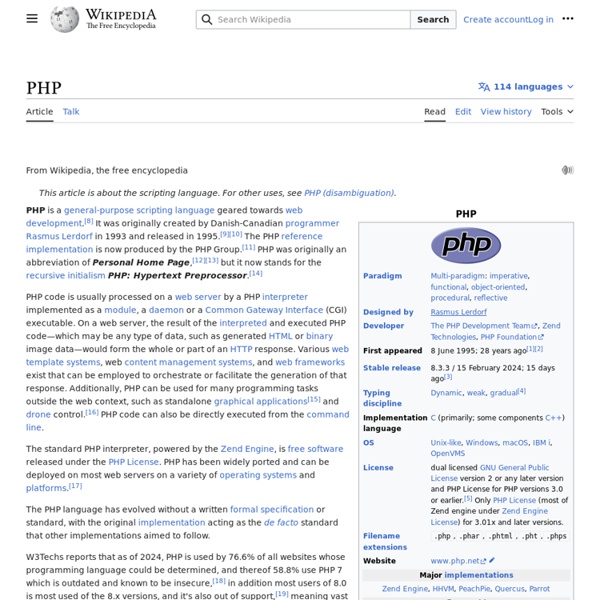



PHP Programming PHP is a scripting language designed to fill the gap between SSI (Server Side Includes) and Perl, intended for the web environment. Its principal application is the implementation of web pages having dynamic content. PHP has gained quite a following in recent times, and it is one of the frontrunners in the Open Source software movement. Its popularity derives from its C-like syntax, and its simplicity. PHP is currently divided into two major versions: PHP 4 and PHP 5, although PHP 4 is deprecated and is no longer developed or supplied with critical bug fixes. If you've ever been to a website that prompts you to login, you've probably encountered a server-side scripting language. Basically, PHP allows a static webpage to become dynamic. Before you embark on the wonderful journey of Server Side Processing, it is recommended that you have a basic understanding of the HyperText Markup Language. Setup and Installation Note: Before contributing, check out the discussion page. The Basics
Hypertext Transfer Protocol The Hypertext Transfer Protocol (HTTP) is an application protocol for distributed, collaborative, hypermedia information systems.[1] HTTP is the foundation of data communication for the World Wide Web. The standards development of HTTP was coordinated by the Internet Engineering Task Force (IETF) and the World Wide Web Consortium (W3C), culminating in the publication of a series of Requests for Comments (RFCs), most notably RFC 2616 (June 1999), which defined HTTP/1.1, the version of HTTP most commonly used today. In June 2014, RFC 2616 was retired and HTTP/1.1 was redefined by RFCs 7230, 7231, 7232, 7233, 7234, and 7235.[2] HTTP/2 is currently in draft form. Technical overview[edit] URL beginning with the HTTP scheme and the WWW domain name label. A web browser is an example of a user agent (UA). HTTP is designed to permit intermediate network elements to improve or enable communications between clients and servers. History[edit] The first documented version of HTTP was HTTP V0.9 (1991).
2012-07-16 - Absolute Beginners Guide to Drupal PHP: Hypertext Preprocessor VsPhp This page was copied mindlessly from (Google Cache) Common Ground Both PHP and Python: are interpreted, high level languages with dynamic typing are OpenSource (except where various Zend products, recommended by some, are employed) are supported by large developer communities are easy to learn (compared to C++, Perl) are easy to extend in C, C++ and Java are extremely portable. They run on almost all platforms in existence without recompilation. support for variable number of function arguments. have the ability to freeze live objects in a string representation (for storing arbitrary objects on disk, moving them over the network, etc); they can then be converted back to identical objects with data intact. Compared as Languages What strengths do PHP have that Python doesn't? What weaknesses does PHP have that Python doesn't? (more verbose) syntax from C/C++ and Perl, with lots curly braces and dollar signs and "->"-s confused tableau of function names.
Internet Protocol This article is about the IP network protocol only. For Internet architecture or other protocols, see Internet protocol suite. The Internet Protocol (IP) is the principal communications protocol in the Internet protocol suite for relaying datagrams across network boundaries. Historically, IP was the connectionless datagram service in the original Transmission Control Program introduced by Vint Cerf and Bob Kahn in 1974; the other being the connection-oriented Transmission Control Protocol (TCP). The first major version of IP, Internet Protocol Version 4 (IPv4), is the dominant protocol of the Internet. Function[edit] The Internet Protocol is responsible for addressing hosts and for routing datagrams (packets) from a source host to a destination host across one or more IP networks. Datagram construction[edit] Sample encapsulation of application data from UDP to a Link protocol frame IP addressing and routing[edit] IP routing is also common in local networks. Reliability[edit] Security[edit]
CMS comparison - WordPress vs Joomla vs Drupal / WebsiteSetup.org If you’re thinking about building a website or blog, you should consider using one of the best CMS available in the market. A CMS (content management system) helps you create, manage, and modify the contents of your website without the need for any HTML or CSS coding skills. The easy-to-use nature of the modern CMS platforms means that anyone can build themselves a great-looking website all on their own. You don’t need to be a web developer, a designer, or have any previous experience with website building either. In this post, we look through three of the most popular and best CMS platforms coming into 2020, compare their pros and cons, and help you pick one. The three best CMS that we’re looking into are: WordPressJoomlaDrupal Here’s everything you need to know about them: 1. Talking about the costs involved in using any of these CMS gets real tricky real fast. These side costs involve chiefly two things: a domain name and web hosting. A domain name is your website’s address on the web. 2.
Less PHP Database Code Using The Factory Design Pattern | Gerd Riesselmann: Notes From the Bog It's PHP design pattern time again! Today I'll show a simple way to Encapsulate database access in a classMake queries return objects rather than records or arraysReduce code to process database results All this is achieved by using the factory pattern. Read on! It usually is a good idea to encapsulate database access into a class. If you start to wrap db code fragments into a class, however, you'll notice that having hidden MySQL inside a neat little class, you still have code like while ($record = mysql_fetch_array($dbHandle)) doSomething($record); spread all over your application. Well, not necessarily. The idea of the factory pattern is to use a function to create an instance of a class rather than calling the constructor using new. Let's start with a simple class like this one: class Person { var $firstName = ""; var $lastName = ""; var $age = 0; function Person($firstName, $lastName, $age) { $this->firstName = $firstName; $this->lastName = $lastName; $this->age = $age; } }